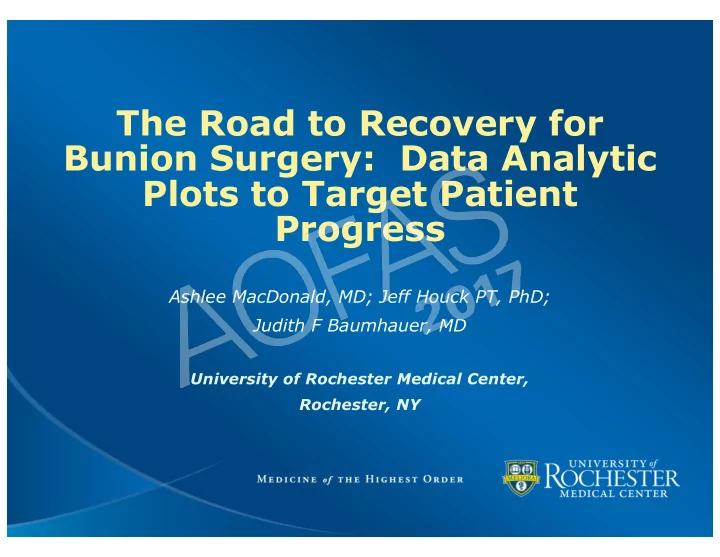

The Road to Recovery for Bunion Surgery: Data Analytic Plots to Target Patient Progress Ashlee MacDonald, MD; Jeff Houck PT, PhD; Judith F Baumhauer, MD University of Rochester Medical Center, Rochester, NY
Disclosures • Ashlee MacDonald, MD: No conflicts to disclose • Jeff Houck, PT, PhD: No conflicts to disclose • Judith F. Baumhauer: • American Orthopaedic Foot and Ankle Society: Board or committee member • PROMIS Health Organization (PHO): Board or committee member • Additional disclosures can be found on the AAOS website. 2
Introduction/Purpose: Power of Patient reported outcomes (PROs): • Provide information on individual patient’s progress throughout a treatment course • Generate data analytic curves à Predictable Recovery Roadmap • Patients who deviate negatively: may have a complication and early intervention can be initiated. • Patients who deviate positively: potential to need less physical therapy, early return to sports or work. 4.4 million patients with Hallux Valgus seek care yearly and surgery is equally common. Purpose: To determine if PROMIS PROs can be used to construct data analytic curves for HV surgery. 3
Methods • PROMIS scores prospectively collected between February 2015 and November 2016. • 65 patients undergoing bunionectomy were identified using ICD-9/10 and CPT codes • 31 patients met exclusion criteria: • < 2 month follow-up • Multiple unrelated procedures during the follow-up period • Incomplete PROMIS scores • 35 patients included in the study. 4
Methods • Bunionectomy-specific pre-operative cut-off values to achieve and fail to achieve minimally clinically important differences (MCID) in physical function (PF) with 95% specificity and 95% sensitivity were determined using a previously described method. • Patients stratified based on their pre-operative PF T-scores as above or below the MCID cut-off of 50.2. • PF was evaluated at 4 follow-up time periods: • 1 week post-op • 3-4 weeks post-op • 6-12 weeks post-op • > 13 weeks post-op* • *Due to small sample size, data from 13-week follow-up was not included in the statistical analysis 5
Results PROMIS Physical Function Scores Average Age Sex 6-12 Follow-up 1 week 3-4 week Pre-op week (weeks) follow-up follow-up follow-up All patients 55.43 + 32 F 17.5 + 48.07 + 31.44 + 35.59 + 45.15 + (n = 34) 13.69 2 M 9.63 7.11 11.10 7.84 7.94 High Pre-op 53.08 + 12 F 13.45 + 55.75 + 33.07 + 37.44 + 49.30 + Score (PF > 12.51 1 M 6.62 4.69 12..60 6.42 5.75 50.2; n = 13) Low Pre-op 56.82 + 20 F 19.90 + 43.53 + 30.47 + 34.50 + 42.70 + Score (PF < 14.44 1 M 10.44 3.34 10.30 8.53 8.14 50.2; n = 21) 6
Results PROMIS Physical Function 70 Figure 1. Trends in PF stratified based on pre-operative PF cut-off * score of T-score > 50.2. 60 Significant differences observed at * pre-op visit (p < 0.01) and at 6-12 50 weeks follow-up (p = 0.02). **Data points at > 13 weeks T-Score 40 represent averages only and are not included in data analysis due 30 to small sample size (n = 5 for high score, n = 15 for low score) 20 Low Pre-op Score 10 High Pre-op Score 0 PRE-OP 1WK 3-4WKS 6-12WKS >13WKS** 7
Conclusion/Discussion • Pre-operative PROMIS PF scores are significant post-operative predictors. • Patients with pre-operative scores below the bunionectomy-specific cut-off (50.2): • Met MCID threshold with changes in PF • T-scores significantly lower at 6-12wk follow-up compared to patients with pre-operative PF > 50.2. • Although short term follow up suggests a significant clinical impact of using PROMIS scores for pre-surgical decisions as well as provides a road map for recovery for patients and surgeons. 8
References • 1. Coughlin MJ, Jones CP. Hallux valgus: demographics, etiology, and radiographic assessment. Foot Ankle Int 2007 Jul;28(7):759-77. • 2. Ho B, Houck JR, Flemister AS, Ketz J, Oh I, DiGiovanni BF, et al. Preoperative PROMIS Scores Predict Postoperative Success in Foot and Ankle Patients. Foot Ankle Int 2016 Sep;37(9):911-8. • 3. Hung M, Baumhauer JF, Latt LD, Saltzman CL, SooHoo NF, Hunt KJ, et al. Validation of PROMIS (R) Physical Function computerized adaptive tests for orthopaedic foot and ankle outcome research. Clin Orthop Relat Res 2013 Nov;471(11):3466-74. • 4. Papuga MO, Beck CA, Kates SL, Schwarz EM, Maloney MD. Validation of GAITRite and PROMIS as high-throughput physical function outcome measures following ACL reconstruction. J Orthop Res 2014 Jun;32(6):793-801. • 5. Perera AM, Mason L, Stephens MM. The pathogenesis of hallux valgus. J Bone Joint Surg Am 2011 Sep 7;93(17):1650-61. • 6. Roddy E, Zhang W, Doherty M. Prevalence and associations of hallux valgus in a primary care population. Arthritis Rheum 2008 Jun 15;59(6):857-62. 9
Recommend
More recommend